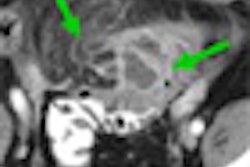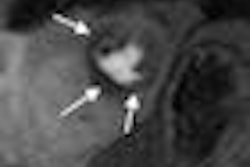Coronary CT angiography (CTA) with prospective electrocardiogram gating allows accurate evaluation of coronary artery disease with significantly less radiation dose than conventional invasive angiography, according to a study from the German Heart Center in Munich.
The study examined 42 patients who were referred for elective invasive angiography due to suspected coronary artery disease. They elected to undergo low-dose coronary CTA following IV contrast administration and without calcium scoring the same day before angiography (Heart, October 2009, Vol. 95:20, pp. 1656-1661).
Dose-area product of angiography and coronary CTA were measured, converted into effective radiation doses, and compared along with the accuracy of the two techniques for detecting clinically significant stenoses (≥ 50%).
Researchers found that coronary CTA with prospective electrocardiogram gating delivered an estimated mean effective radiation dose of 2.1 ± 0.7 mSv (range, 1.0-3.3), compared to 8.5 ± 4.4 mSv (range, 1.4-20.5) for angiography.
CTA cleared 19 patients (42.9%) of coronary artery disease, and another 40 (95.2%) were correctly classified as having significant disease (23/23) or no disease (17/19).
How good was image quality with prospective gating? More than 97% (551/567) of segments were evaluable based on the 17-segment American Heart Association model. Compared to the reference standard of conventional angiography, the sensitivity, specificity, and positive and negative predictive values were 94.2% (confidence interval [CI]: 0.8-1.0), 94.8% (CI: 09-1.0), 89.0% (CI: 0.8-1.0), and 97.4% (CI: 09-1.0), respectively, with accuracy of 94.6%.
Calling the paper a first comparison of the two techniques, lead author Dr. Bernard Herzog and colleagues concluded that "our results not only confirm the feasibility and reliability (accuracy versus invasive coronary angiography) of this low-dose ... protocol but also show that [effective dose] is significantly lower by about 75% than in coronary angiography," they wrote. "This holds true for each individual patient and independently from body mass index and was not subject to a large interindividual variability," in contrast to the high variability of the angiography results.
Related Reading
Cardiac CT matches SPECT for perfusion analysis, September 17, 2009
Negative CCTA clears chest pain patients for 3 years, inexpensively, August 26, 2009
Coronary CTA beats calcium scoring for short-term prognosis, August 14, 2009
Study correlates CTA to angiography, myocardial perfusion SPECT, May 25, 2007
Stress MPI with Tc-99m SPECT identifies high-risk obese patients, September 1, 2006
Copyright © 2009 AuntMinnie.com



















